Slade's Morgue:
Primal Scream (Shrink)

Japanese edition of PRIMAL SCREAM


PRIMAL SCREAM (British title SHRINK) is Michael Slade's stand-alone sequel to HEADHUNTER. Here's the story behind it.
As with every Slade psycho-thriller, the plot came out of his youth.

King of the Cowboys
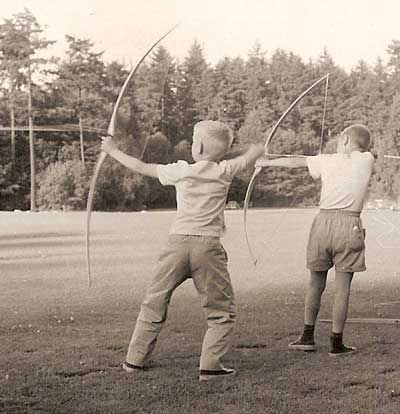
Winterman Snow (left) lets one fly

The Mad Trapper of Rat River, dead
Slade's roots sink deep into the Wild West (see BIO). In 1883 (7 years after Custer's Last Stand, see CUTTHROAT), his great-grandfather, George Murdoch, crossed the Canadian Prairies alone through Indian territory in a wagon pulled by an ox and a mule.

George Murdoch (1850 - 1910)
"Scotty" Murdoch settled among Crowfoot's Blackfoot warriors - who called him "Leather Man" - outside the North-West Mounted Police stronghold of Fort Calgary, back when it looked like this.

Fort Calgary, where the Bow and Elbow Rivers meet, in the 1880s


Chief Crowfoot

George Murdoch's (he's on the right) log shack in 1883
Murdoch set up business as a harness maker. In February 1884, he stopped a lynching. After a murder at the general store, an angry mob was all for hanging Jesse Williams high. Murdoch insisted on a fair trial.
That same year, he collected enough money and pioneer signatures to have Calgary's 200 settlers incorporated as a town. In December, he became its first mayor...
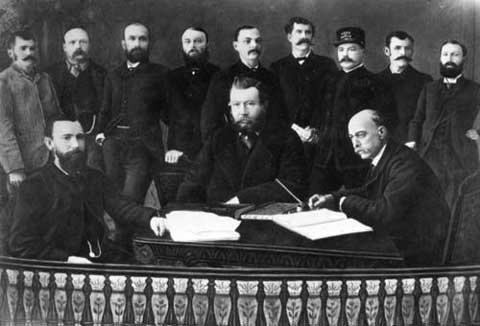
Calgary's first town council, 1884
...and served as its first judge. His diary (now in the Canadian Archives) describes a court case: "A strange sight, civilians, military, and Indians in paint looking in at the windows."
In the 1880s, Canada's North-West Territory - including Fort Calgary and Murdoch's new town - was a tense, volatile wilderness.

WHEN SIOUX AND BLACKFOOT MEET by Charles Russell (1903)

SIOUX TORTURING A BLACKFOOT BRAVE by Charles Russell (1897)
The Blackfoot were longtime enemies of the Cree and the Sioux. The Canadian Cree fought with Sitting Bull at Custer's Last Stand. Then - to avoid the wrath of the U.S. Army - the American Sioux crossed the "medicine line" into Canada's North-West Territory.
The duty of the Mounties was to police the Canadian plains. To keep the tribes from warring. To subdue the fugitive Sioux. To prevent cross-border raids. And to bring all North-Westerners under Canadian law.
Red serge was chosen to keep the Mounties' uniform well apart from the blue coats of the U.S. cavalry.

CANADIAN MOUNTED POLICE by Frederic Remington (1890)

Mounties on parade at Fort Calgary in 1883

Mounties at ease at Fort Calgary in 1879

ARREST OF A BLACKFOOT MURDERER by Frederic Remington (1888)

CANADIAN MOUNTED POLICE ON A WINTER EXPEDITION by Frederic Remington (1887)
The buffalo herds were essential for plains tribe survival. With the coming of white hunters, they vanished overnight. Bison were slaughtered for their hides, and the bones were shipped east for fertilizer.
During his 1883 trek across the North-West, Murdoch had seen the prairie littered with buffalo bones, all that remained of the great herds that once covered the plains. Moose Jaw's industry, he wrote, consisted of collecting and shipping buffalo bones.

Moose Jaw, Saskatchewan (1885)

Saskatoon, Saskatchewan (1890)
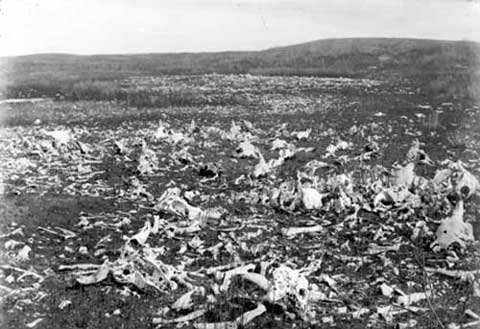
Littering the plains

A pioneer yard sale

The meat was left to rot
By the spring of 1885, the plains tribes were starving. Big Bear's destitute Cree were camped near Frog Lake, north of Calgary, in what is now Alberta.

Chief Big Bear
At the end of March, Louis Riel's Metis rose up and defeated the Mounted Police detachment at Duck Lake, Saskatchewan. The North-West Rebellion of 1885 was on.

BATTLE OF DUCK LAKE (1885)
When news of the Mounties' defeat at Duck Lake reached Big Bear's camp, Wandering Spirit - the war chief - erected his war lodge. Under Cree custom, that passed control of the Frog Lake warriors from Big Bear to him.
Wandering Spirit had killed at least 11 Blackfoot in battle. His war bonnet was a lynx skin wrapped around his head and decorated with eagle feathers. Early on April 2, after a late-night war dance, he led a food raid on the Hudson's Bay Company store at Frog Lake.

War Chief Wandering Spirit (1886)
Hoping to defuse tensions with the hungry Cree, Thomas Quinn, the detested Indian agent, had sent Frog Lake's Mounties away.

Thomas Quinn
In ransacking the store for food, the Cree found alcohol. When Wandering Spirit tried to take his prisoners back to camp, Quinn refused to go. Consequently, the war chief shot him in the head. An alcohol-fueled altercation erupted, and when it was over, 9 white men lay dead. Including two Catholic priests.

The Frog Lake Massacre (1885)

THE MARTYRS OF FROG LAKE
Having killed their husbands, the triumphant Cree abducted 2 white women, Theresa Gowanlock and Theresa Delaney.

Theresa Gowanlock
Two weeks later, on April 15, 200 Cree warriors descended on Fort Pitt and forced the 25 Mounted Police, under the command of Inspector Francis Dickens, the son of novelist Charles Dickens, to capitulate.

BATTLE OF FORT PITT (1885)
News of the Frog Lake Massacre spread like wildfire. Nothing ignited whites' primal fear like the mass killing of settlers, the "martyring" of priests, and the abduction of white women. A few months into his job as mayor and Murdoch had a crisis. Would the Blackfoot rise and wipe out Calgary?
After helping Calgarians arm to defend the town from attack, Murdoch stood guard at night. Convinced the rebels were doomed to fail, Crowfoot refused to join in. Within months, the Blackfoot chief was right.

The surrender of the Cree by Robert William Rutherford (1887)

The rescue of the abducted women, Gowanlock and Delaney (1885)
Those killed in the Frog Lake Massacre were buried in this graveyard.

On November 27, 1885, War Chief Wandering Spirit and 5 Cree involved in the Frog Lake Massacre (along with 2 Assiniboine warriors) were hanged at Battleford. About 350 Mounties watched the largest public hanging in Canadian history.
The bodies were buried in a common grave, and later covered by an unmarked concrete slab.

1885 was a watershed year. It marked not only the passing of Canada's Wild West, but also the start of what can accurately be called the attempted cultural genocide of its Native people.

North American edition of PRIMAL SCREAM
Once your head's cut off, that's the worst that can happen to it, right?
Wrong...
PRIMAL SCREAM begins with an exchange of gunfire between present-day Mounties and Native Indian militants who have seized a stretch of sacred land around Totem Lake in northern British Columbia to resurrect the Sun Dance. While dodging bullets, one of the cops discovers the arrow-shot body of a headless man frozen under the ice. Enraged by cultural and sexual abuse in a government-sanctioned residential school in his youth, Winterman Snow - an albino Indian and a psychotic archer - is on the hunt.
Meanwhile, in Vancouver, Chief Superintendent Robert DeClercq receives a grisly taunt. The head sent anonymously by mail is no bigger than a baseball and bleached the same ashen white, with stitching that seals a withered pair of lips and two sunken eyes. Years ago, the Headhunter pushed DeClercq to the brink of hell. Has that psycho returned to shove him over the edge?
Canada's Western frontier is gone; but not its frontier to the North. There, in a bone-chilling chase reminiscent of the Mad Trapper of Rat River, the hunter becomes the hunted in a desperate bid to rescue an abducted hostage from an isolated winter cabin haunted by historic primal screams.

SUN DANCE by Frederic Remington (1888)

INDIAN SUN DANCE by George Catlin (c. 1850)

SUN DANCE by George Catlin (1857)

Sun Dance (detail) by George Catlin (1871)

CREE INDIANS PERFORMING A SUN DANCE (1886)

SUN DANCE photo by Edward S. Curtis (c. 1908)

INDIAN SUN DANCE, Battleford, Saskatchewan (1895)

BLACKFOOT SUN DANCE CAMP (c. 1908)

INDIAN SUN DANCE, MAKING A BRAVE in Alberta (1886)
To the Blackfoot, Cree, Sioux, Cheyenne, Ojibway, Kiowa, Arapaho, Assiniboine, Shoshone, and other Plains tribes, the Sun Dance was their most important religious ritual. The dance involved making a personal flesh-sacrifice to the Great Mystery for the benefit of one's family and tribe. Braves tethered themselves to a central pole by skewers stuck through the skin of their chests. While dancing to drums, sun-gazing, and blowing bone whistles, the ritualists struggled to tear themselves free from restraint.
In 1885, Canada's government amended its Indian Act to ban Plains tribe flesh-sacrifice and Totem tribe Potlatch gift-giving. The goal was to gut their religions and thereby suppress Native cultures. From then until repeal in 1951, sun dancers were persecuted.

John Schlamp
John Schlamp was from Galicia, the turbulent crossroads of Eastern Europe occupied at various times by barbarian Goths, Vandals, and Huns. It was later invaded by the Golden Horde of Genghis Khan, and shared the Carpathian Mountains with Dracula's Transylvania.

Europe in 1918, with Galicia in red
John Schlamp was in the Prussian Army, where he learned 5 languages and many dialects while serving around Europe. On his discharge, he found work as a gardener in Vienna.
Elizabeth Flesner was born into wealth and title. She lived in a gated mansion with many servants at the heart of the Austro-Hungarian Empire.

Austro-Hungarian Empire in 1913
It's said that Elizabeth had never combed her own hair until she fell in love with the gardener and was disowned by her family. Some clothes were thrown into a single suitcase, and the gates slammed shut behind the carriage that left the Vienna mansion. She never saw her family again.
Having married and settled in Galicia, the Schlamps had 5 children, who all died in a plague. During what's known as the Great Economic Emigration, they left for a new start in Canada's North-West Territory in 1887. There, they farmed and had 8 more children. (By Slade's calculation, all told Elizabeth was pregnant for 9.75 years.) Thanks to his many languages, John also interpreted for the law courts.
Slade's pioneering great-grandparents - the Murdochs and the Schlamps - were well-positioned to experience the passing of Canada's Wild West and the forging of the Myth of the Mounties. Imagine the frontier tales that echoed down through two generations to Slade's thirsty ears.
With the blood of headhunting Picts in Scotland (see BURNT BONES) and the blood of barbarian Goths, Vandals, Huns, and Mongols in Galicia flowing in Slade's veins - along with (he'd like to think) the cold blood of the undead from neighboring Transylvania - you have the answer to the question every author hears: "Where do you get your ideas?"
Turbulent blood.

Hal Foster's PRINCE VALIANT battling Slade's ancestors

Jack Clarke, Slade's father, was a professional illustrator for Associated Screen News before WWII (see CRUCIFIED). Of all the artists who drew newspaper comics, Clarke considered Hal Foster to be the best. Foster began with TARZAN, before he created PRINCE VALIANT. Slade received the above book when he was 8.
Of all the images that reflect the Myth of the Mounties (roam the Internet and you'll find hundreds), Slade thinks Foster's wins the crown.
Here are three more:

SINGLE-HANDED by Charles M. Russell (1912)

Mountie painting by John Innes (c. 1930)

CATTLE THIEF by Arthur Heming (1920)
1897 was another watershed year. Empire guardians were gathering in London for Queen Victoria's Diamond Jubilee, and to celebrate the occasion, the Mounties had a new official hat: the Stetson.
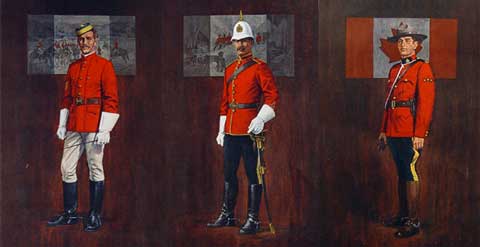
Evolution of "the Mounted"

A North-West Mountie in 1897
Just as the Mounted contingent was preparing to depart for London...

...their going-away gala Red Serge Ball was interrupted by news that Almighty Voice, a Plains Cree...

Almighty Voice
...had killed 2 Mounties (3 including Sergeant Colebrook 19 months earlier), plus 1 civilian, and had wounded other redcoats. The Last War Cry was on.
Out of that came Michael Slade's first novel, HEADHUNTER. You'll find the full story here.
 r
rThe Myth of the Mounted Police - "The Mounties always get their man!" (coined by the Fort Benton, Montana RECORD in 1877) - really took hold at the turn of the century.
On Christmas Day 1899, George O'Brien - an ex-con from England's Dartmoor Prison - ambushed and murdered three men on their way to turkey dinner at the Mounted Police post. Stripping the bodies of valuables, he pushed the victims through a hole cut in the icy Yukon River.

George O'Brien
Constable Alick Pennycuick - "the Sherlock Holmes of the Mounted Police" - spent months scouring 40 square miles of snowy bush for clues. In O'Brien's camp, he found charred clothes, a skull fragment, a broken tooth embedded in a bullet, and an ax with a nick in the blade that matched marks on the trees chopped down to build the ambush platform.
When spring thaw gave up the bodies, a tooth stump in one man's jaw jigsawed with the fragment from O'Brien's camp.
An early case of forensics. CSI Yukon?

O'Brien's trial
Covered by all the national papers, the courtroom was packed for O'Brien's trial. After 63 witnesses, it took the jury less than two hours to convict. O'Brien was hanged in August 1901.

Ernest Cashel (1903)
Ernest Cashel was a drifter from Buffalo, Wyoming. In 1902, he was arrested in Calgary for forgery. Cashel escaped from jail and found work as an odd job man for Lacombe rancher Isaac Belt. Around Halloween, Belt vanished along with his horse, saddle, shotgun, and money.
Cashel returned to Calgary wearing Belt's clothes. He was jailed for theft. When Belt's badly decomposed body was found floating in the Red Deer River with a bullet hole in its chest, "Sherlock" Pennycuick stepped in. After months of painstaking investigation, the Mountie was able to convict Cashel of Belt's murder.
Five days before Ernest was to hang on December 15, 1903, his brother John came from Wyoming for a death cell goodbye visit. John managed to slip a pair of revolvers through the bars, and that night, Ernest made a dramatic escape.
John was captured quickly...

John Cashel's arrest in Calgary in 1903
...as the Mounties launched the largest manhunt in North-West history to track Ernest. The price on his head was $1,000, a huge reward back then.

Note the detailed description in Cashel's wanted poster
For 46 days in the dead of winter, posses of up to 40 mounted constables stalked the fugitive. Again, the sensational story was covered by the national press. Finally, in late January, the Mounties cornered Cashel in the cellar of a shack on the outskirts of Calgary. A shootout ensued before they torched the shack to literally smoke the desperado out.
On February 2, 1904, Ernest Cashel was hanged in Calgary's prison yard.

"Famous Cases of the Ruthless Renegades"
In the spring of 1902, a murdered man was found near Morningside, Alberta. Except for a pair of suspenders labeled "Kalamazoo," there was nothing on the body to identify the victim.
By chance, a local doctor told Sergeant Harry Hetherington about a missing person ad placed in an Alberta paper by a worried mother in Kalamazoo, Michigan. The Mountie went to Kalamazoo to interview the woman. She informed him that her son, Leon Stainton, had gone west with a man named Bud Bullock.
Armed with Bullock's signature from a Michigan hotel register, Hetherington went undercover. Using a false name, he worked his way west to compare the scrawl with those in hotel registers and on the payrolls of mining companies. After three months, he found Bullock mining in Great Falls, Montana.
Arrested and returned to Alberta, Bullock was hanged.

Mounties practice bayoneting bad guys at Fort Calgary
(c. 1900)
Billy was his real name (Slade kids you not), but he dubbed himself "the Idaho Kid." In 1903, the Kid crossed the border to Weyburn to take on the Myth of the Mounties and thereby gain his fame. Swaggering down the main street, he took pot shots at verandas and one man's hat. "If a Mountie tries to stop me," he shouted, "I'll eat his liver cold."
Terrified townsfolk wired the nearest Mounted Police detachment: "Come up next train party running amok with revolver."
In a reverse of HIGH NOON, Constable Henry "Larry" Lett stepped down from a freight train. If the Kid had hoped for a mano-a-mano main street walkdown with cries of "Fill your fist!", it was not to be.
Born in Ireland, Lett first got into uniform with the Royal Irish Dragoons. He'd spent his life fighting with various regiments in Egypt, India, and South Africa's Boer War. There, he'd won both the Queen's and King's medals.
The Kid was relaxing with his wife in a shot-up Weyburn hotel room when Lett kicked in the door and tackled him as he reached for his gun. A fierce fight followed in which the wife joined in, but ultimately, Lett snapped on the cuffs and hauled the Kid off to jail.

Don't fence me in...
In the above poster for Calgary's Dominion Exhibition, note the sign in the lower left corner: "Visit Alberta before the Indians...are gone." That wasn't promotional hype. It was Canada's ethnocide goal.
Gutting Native religions by banning the North-West Sun Dance and the West Coast Potlatch was just one step. The aim of the Gradual Civilization Act (1857) was "to kill the Indian in the child." To that end, all aboriginal children between ages 6 and 15 were forcibly removed from their families and compelled by law to live at church-run residential schools. Sixty percent were Roman Catholic institutions, and the rest adhered to other Christian faiths. Due to the distance between the schools and the sites of child abduction, some kids didn't see their parents for years.

A North-West Indian residential school in 1885
Note the visiting parents camped outside the gate
To assimilate young aboriginal minds into white European culture - to "civilize" them - Native school residents were corporally punished for speaking their own language or practicing their own faith. Only English, French, and Christianity were allowed. Forced labor funded the schools. With such easy pickins at captive young flesh that couldn't complain, exactly what you'd expect happened. Some residential schools became hotbeds of physical and sexual abuse by Christian fanatics, racists, sadists, and pedophiles.
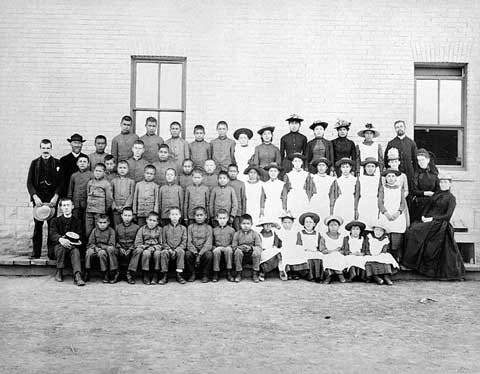
A North-West Indian residential school in 1901
Note all the happy faces
The last residential school closed in 1996. In 2005, Canada's government confessed that the Indian schools were "the single most harmful, disgraceful, and racist act in our history." Billions of dollars in compensation resulted. In 2009, Pope Benedict XVI apologized for abuse at the Catholic schools.
In his court cases, Slade witnessed the fallout from all that psychological trauma.
Motive for murder?

In his final years, the Leather Man was paralyzed. His sons would drive him downtown in the family phaeton, a deluxe model horse-drawn buggy...
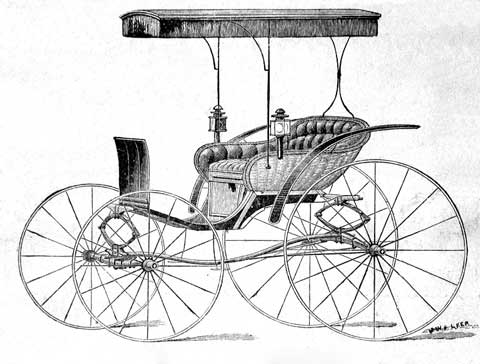
...where Murdoch would converse for hours about the Old Days with his Blackfoot friends in their tongue. When the "Father of a City" died in 1910, that marked the end of Calgary's pioneer era.
Well, sort of.
Two years later, Calgary launched its first Stampede. The impetus came from Guy Weadick, an American cowboy performer, who pitched the Calgary Stampede as a Wild West rodeo that would "make Buffalo Bill's Wild West Extravaganza look like a sideshow."
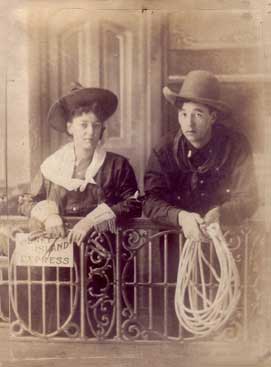
Rope trick riders Guy Weadick and Florence LaDue, his wife
(c. 1912)
The first Stampede was bankrolled by wealthy Alberta cattlemen dubbed "the Big Four." Lane and McLean were ranchers; Burns ran a meat-packing plant; and Cross owned a brewery. The prize money offered was 4 times that of other rodeos, so cowboys from every corner of the West galloped in.


The Calgary Stampede Parade (1912)
In 1919, the Calgary Victory Stampede celebrated soldiers returning from World War I, in which the British Empire lost 1,225,914 dead, with 2,090,212 wounded. Soldiers on horseback had charged into battles to win "glory" the old way, and had been ground to mincemeat by mechanized weapons. Tanks, machine guns, biplanes, and big artillery.
Here was an escape. A return to yesteryear.

If you know your cowboys, you know the names Tom Mix and Hoot Gibson. They were early Hollywood's biggest Western stars, later replaced by the singing cowboys: Roy Rogers and Gene Autry.

Tom Mix as a Mountie (1920)

Hoot Gibson at the Calgary Stampede (1925)
In the decades that followed, Hollywood produced more than 250 Mountie movies, known in the biz as Northerns (distinct from Westerns).


A horse rears up in the Stampede Parade (c. 1920s)
Promoted as "A Carnival of Cowboy Sports Open to the World," the Calgary Stampede showcased bull riding, barrel racing, steer wrestling, tie down roping, saddle bronc, and bareback riding.

Bareback riding (1955)
Called "the half-mile of hell" (4 horses died in 2010, adding to many in years past), roughriding chuckwagon races began in 1923.

A chuckwagon race (c. 1940s)
Pancake breakfasts and barbecues were - and still are - free

Buffalo barbecue (1923)
As their children were brainwashed and physically abused at government residential schools to "kill the Indian" in them, the Blackfoot and other Plains tribes were huge Stampede crowd-pleasers.

Blackfoot (1927)

Stampede Indian (c. 1940)

Blackfoot women, with a child too young for brainwashing
The Mounted Police, of course, were at the heart of the Calgary Stampede. They were in the first parade...

Mounties at the Stampede in 1912
...and in every parade thereafter.

Mounties at the Stampede in 1925

Mounties at the Stampede in 1935
Not only did the city evolve from the Mounties' Fort Calgary, but the Stampede provided the ideal forum for their world-famous Musical Ride.

THE CHARGE OF THE NORTH-WEST MOUNTED POLICE MUSICAL RIDE by Frederic Remington (1887)

The Musical Ride at the Calgary Stampede (1925)

The Wagon Wheel formation

The Musical Ride at 1939's New York World's Fair
By 1930, the Myth of the Mounties survived as a frontier relic from their Wild West past. Alberta and Saskatchewan had been carved out of the North-West Territory in 1905, leaving the new Northwest Territories a vast stretch of snowy, icy tundra up north in the Arctic. In 1920, the North-West Mounties had morphed into the Royal Canadian Mounted Police. Now, the dismounted Mounties rode around in cars.
Then, in 1931, something thrilling happened.
Albert Johnson, a short, wiry drifter about 40 years old, rafted down the Peel River to Fort McPherson in the Northwest Territories. He purchased an arsenal of guns from the Hudson's Bay Company, then left to build himself a hermit's cabin near the Rat River.

Mounted Police report on Johnson
When local Natives complained of tampering with their traplines, 4 Mounties mushed 65 miles by dog sled to search Johnson's cabin.

A Mounted Police dog sled
On December 31, 1931, Johnson refused to answer pounding on his door. Constable King was raising an ax to chop it in when a bullet ripped through the wood and hit him just below the heart. After returning fire, the others retreated on a grueling 20-hour race across the Arctic in bitterly cold, -42 degrees Celsius weather to save King's life.
January 9, 1932 saw a Mountie posse of 8 men, 42 dogs, and 20 pounds of dynamite return to the Rat River cabin with gun slits through its logs. During a 15-hour siege, the police threw explosives and collapsed the cabin. When Johnson continued firing, again they retreated.

The dynamited cabin
The dramatic manhunt in the Arctic caught the public's imagination. The Canadian press tagged Johnson as the "Mad Trapper," while American newspapers - having coined the motto - asked "Will the Mounties get their man this time?" It was like the hunt for Ernest Cashel in 1903-04, but with a huge difference.
Radio.
Some stories rivet the public's attention day after day after day. "Baby Jessica" trapped down a Texas well in 1987. The Beltway Snipers on the loose in 2002. The rescue of the Chilean miners in 2010. And back in 1932, millions followed the Arctic chase on their radios.
On January 16, the posse returned to the cabin, 21-men strong. Johnson had escaped, probably heading for the Alaskan border, so a tracking team of 4 men set out after him.
For 2 weeks, the fugitive outfoxed his pursuers by tramping up creekbeds so no snow would leave tracks, and by trudging in ever-widening circles until he seemed to vanish, wearing his snowshoes backward to baffle the hunters.
Finally, smoke was spotted twisting up from a ravine. Johnson lurked in ambush behind a fallen tree. As the trackers plowed through deep snow into the darkening gorge, a marksman's shot from the elusive trapper dropped Constable Edgar Millen dead.

Millen and his dog team
Again, Johnson escaped.
By traveling solo and living off the land, the deadly Mad Trapper had logistics on his side. Johnson could be anywhere along the Arctic Circle. So that's when the Aklavik RCMP called in Wop May.

Wilfrid "Wop" May was a Canadian World War I flying ace. Not only did he have 13 enemy "kills" to his credit, but he was being chased by the Red Baron, Manfred von Richthofen (later of Snoopy and PEANUTS fame), when pilot Roy Brown (RAF credited) or a shot from the ground fatally wounded the German ace.

The Red Baron wearing his Blue Max
After WWI, Wop May became the first Arctic bush pilot. He promoted himself by wing-walking while flying over rodeos. Only 4 years had passed since Charles Lindbergh's historic solo flight across the Atlantic in Spirit of St. Louis, prompting the world to go aviation-mad.
Suddenly, here was history's first manhunt by bush plane, adding a new frontier dimension for all those radio listeners.

Wop May (far right) with Mounties hunting for the Mad Trapper
In mid-February, the bush pilot spotted footprints branching away from caribou tracks on the frozen Eagle River. Johnson was using the animal trail to hide his own.
Days later, the 150-mile chase ended in a shootout. Cornered in the open on the ice-bound river, Johnson shot one pursuer in the lungs. Moments later, the Mad Trapper was riddled with 9 bullets and died.

The Mad Trapper, dead
To this day, no one knows who the Mad Trapper was. "Albert Johnson" proved to be an alias. On him, the Mounted Police found over $2,000 in Canadian and American bills, 32 kidney pills, a jar of pearls, a jar of gold dental work, a dead squirrel, and a dead bird.

Mounties involved in the manhunt
Constable King (shot through the door) is on the far left
Constable Millen (killed in the gorge) is 2nd from the right

British edition of PRIMAL SCREAM (alternate title)
How many sex killers can a cop take on, and still hold onto his sanity when one of the psychos grabs his child? Robert DeClercq of the Mounted Police is about to find out.
DeClercq is a cop with a tragic past. Decades ago, his job lured kidnappers to his home, and his 6-year-old daughter died in the woods when he failed to get her back. Only now, with Katt in his life, has that terror faded.
It returns full force when a shrunken head is sent to DeClercq. Years ago, the Headhunter almost drove him mad, and now, a psycho is hunting, raping, and beheading men in the same city. Only the sex of the prey differs. Is the Headhunter back?
And what about the psycho loose up North, revealed when a headless body shot with an arrow and frozen in ice surfaces during a shootout between Indian militants and police? Is albino Winterman Snow hunting, raping, and beheading whites to avenge his abuse as a boy at a church-run Indian school?
Only when Katt is kidnapped and his past becomes his present, luring DeClercq north to run a savage gauntlet of merciless cold, will he glimpse the hidden faces of three linked psychos, each intent on taking his head as a trophy.
Revenge is a dish best served cold...

"Bloody, violent, and extreme: what a good yarn! PRIMAL SCREAM walks a fine line between fiction and reality. It's difficult not to believe that the plot is absolutely true. The psycho killers are maniacal, but their behavior has plausible psychiatric cause. Reliable, accurate research is the hallmark of this novel. Through the Cree Mountie Ghost Keeper, who's tracking Winterman Snow, we learn what it was like when the Mounted Police became myth and used dog sleds to get their man. The factual narrative causes the reader to conclude that Special X actually exists, protecting us from the disturbing world of psychopaths among us. As a Crown prosecutor, I deal with cases that are investigated by the Serious Crime Unit of the RCMP. I now intend to look in their Directory under the letter X." - Joseph Bellows, Q.C. in The Vancouver Sun
"The scariest Slade novel thus far. Slade knows how to blend horror and mystery to get a nice mix. There's lots of clever hardware for searching and killing. Fans will love it." - Margaret Cannon in The Globe and Mail
"A corpus of corpses. Michael Slade draws on real-life mayhem to present a moral vision that transcends its fictional vehicle. What Slade writes certainly convinces the experts. He was recently invited to be luncheon speaker at the North American Police Leadership Conference. He writes the cop thrillers that cops read. In PRIMAL SCREAM, death comes in many diabolically imaginative guises." - Max Wyman in The Vancouver Sun
"Michael Slade thrillers are overrun with psycho killers. PRIMAL SCREAM is populated by deviants who litter the landscape with headless bodies and pose grisly mysteries for the Mounted Police. If the emphasis on psychos has won Michael Slade the admiration of gorehounds such as rock singers Alice Cooper and Iron Maiden's Bruce Dickinson, the depiction of cutting-edge investigative work has won him fans among the police. PRIMAL SCREAM's devotion to delivering kick packs quite a wallop." - Chris Dafoe in The Globe and Mail

"Slade's real-life courtroom specialty in the law of insanity explains his ability to explore sick minds so convincingly. PRIMAL SCREAM oozes perversion and wraps it up in a tense plot. Well worth reading." - The Montreal Gazette
"PRIMAL SCREAM is Slade's most horrifying and compelling thriller. A stand-alone sequel of sorts to HEADHUNTER, it delivers what Slade fans have come to expect: demented killers, bizarre crimes, lurid details, good guys, and a story line that never tips its hand. Slade is adept at creating tension and making your brain sprint ahead. PRIMAL SCREAM will have you turning pages well into the wee hours." - The Vancouver Courier
"PRIMAL SCREAM will make you squirm. It takes readers on a spine-chilling roller-coaster ride into the primitive recesses of the psychopath's mind. The plot is a classic whodunit with the mystery solved only on the final pages. Slade's well-developed penchant for realism grips the reader. Look up 'page-turner' in the dictionary and you'll find a picture of a Michael Slade book." - The North Shore News

Michael Slade was born in Alberta - once the North-West Territory - in 1947. His earliest vivid memory is from the 1950 Calgary Stampede: sitting in the saddle with a redcoated Mountie, surrounded by feathered Blackfoot, Blood, and Peigan in full warpaint.
Though he lived in Winnipeg, Manitoba for his first 8 years, and in Vancouver, British Columbia since then, every summer was spent at the Calgary Stampede, where tradition dictates that you dress up in Western garb. Imagine the fun of being a boy in that Cowboy-and-Indian-obsessed era, and having a vast extended family of all those Murdoch and Schlamp settlers feeding you thrilling frontier stories from family archives kept by the pioneers who lived them, while wandering the festive streets in a white Stetson and cowboy boots, with a six-shooter holstered on your hip.
If you took in a movie, Westerns and Northerns were playing at theaters like The Hitching Post.

A 1954 Northern movie
Cap guns in Canada were pathetic toys, dinky static play things with rolls of caps. That was before international kid marketing took hold. But just to the south was this magic land called America, and that's where Slade spied this beauty on display in a toy store window.

Slade's cap gun
The Hubley Colt .45 is one of the biggest cap guns ever made. Beautiful engraving, gold cylinder, nickel plating, and ivory grips. Eat your heart out, General Patton! By removing the bullet nose, each cartridge casing was loaded with a single round cap. Pull down the lever under the barrel and you could snap it open and remove the cylinder. Push down the thumb grip above the trigger and you could load the cartridges one by one.
A kid with a cap gun like that could take on this guy: the best Western villain ever, Jack Palance in SHANE (1953).

A kid with a cap gun like that could be this guy: the best Western hero ever, Richard Boone as Paladin.

But even more fun than playing Cowboys was - in Slade's opinion - playing Indians. He could paint his near-naked body with all these bright designs, stick feathers in his hair, wear a bear claw necklace, and arm himself with a bow and arrows, a tomahawk, and a scalping knife.

Slade made the tomahawk and knife, and did the beading
His father carved the bear claw necklace out of balsa wood
Ah, the innocence of youth.
Later, Slade's practice of criminal law exposed much darker truths about Native experiences. Vancouver has a notorious skid road (see the Pig Farm Case in NEWS). Gastown - the pioneer heart of the city with Slade's law office - the criminal courts, Chinatown, and the crime-infested East End share a few square city blocks. In his 1st year of practice, Slade was "the hookers' lawyer," and a disproportionate number of his clients were Native women enduring the fallout from social dislocations caused by residential schools.
In the early 1970s, a man drinking in a bar mentioned that it would be worth a couple of hundred dollars to him to have a guy fooling around with his wife beaten up. The offer was overheard by a multi-cap heroin addict constantly in need of cash for his next fix. He recruited 2 fellow addicts for a home invasion that resulted in two horrific murders. The targeted victim and a female visitor died from a combination of multiple gunshots fired by a .22 pistol and a rifle, along with knife wounds stabbed in such a frenzy that the blade snapped.
Slade's client was a Native Indian addicted to smack and booze. His father had died before he was born, and his mother had relinquished him to be raised in church-run schools. The judge charged the jury: "He has had a tough and unfortunate life." The anger evident in the crime scene was shocking to behold.

A Native sweat lodge
In December 1994, the Mounties took Slade on a police boat cruise up the West Coast to Jervis Inlet to experience a Native-run spiritual retreat established to inculcate Native values in troubled Native youths. In other words, cleansing the damage done to successive generations by the Indian residential schools.
The Natives asked Slade if he'd like to partake in a sweat lodge ceremony. Wouldn't you?
Fashioned from cedar boughs covered with animal skins, the igloo-shaped lodge faces the rising sun. You back in through the door flap to return to the womb of Mother Earth, from which all creatures are born. While you sit in the dark with just the glow from heated rocks lighting the circle of faces, the shaman uses a cedar bough to splash the stones with water. The ceremony challenges you to purify yourself through confession, song, and prayer. Prayers are said for the Creator, "sisters," "brothers," and yourself. You end what you have to say with "All my relations."
When it gets too hot to bear, you exit for a roll in the snow or a dunk in the river. Wow, was that cold! Then you return for more cleansing.
Imagine the experience of being the only white man in that sacred environment, listening to voice after young voice seeking spiritual guidance to heal the damage done to their lives...knowing you're next.
What would you say?

Sun Dance by Edward S. Curtis (1910)
Natives call it Ts'peten. Maps call it Gustafsen Lake. There, on unceded tribal land in central British Columbia (unlike the North-West Territory, where treaties were signed with the Blackfoot and Cree Nations, Native territory in British Columbia was seized without treaty), Sun Dances took place in the summers of 1988 to 1995.
In 1995, Sun Dance participants remained at Ts'peten longer than usual. When moves were made by local ranchers to evict them, resentful Native militants dug in. Soon, the dispute erupted into a 31-day armed standoff against the Mounted Police. In the largest paramilitary operation in Canadian history, the RCMP deployed 400 Emergency Response Team officers, backed by helicopters, planes, and armored personnel carriers. And in a 45-minute gun battle on September 11, thousands of rounds of ammunition were fired.
That same year, Slade was guest speaker at an upcountry RCMP regimental dinner, and spent time researching ViCLAS (the Violent Crime Linkage Analysis System) and Geographic Profiling with the cybercops at RCMP Headquarters in Vancouver. So, he had a backstage view of the standoff action.
Published in 1998, PRIMAL SCREAM (SHRINK) evolved from all the jigsaw pieces in the backstory above. The stand-alone thriller also completes the story arc of HEADHUNTER.
Here's how it opens:
















